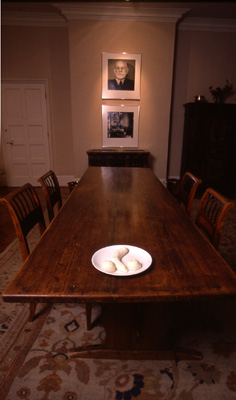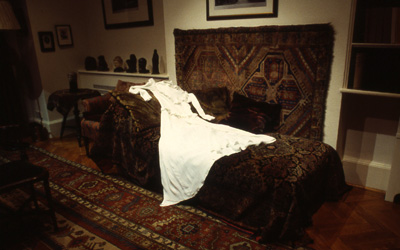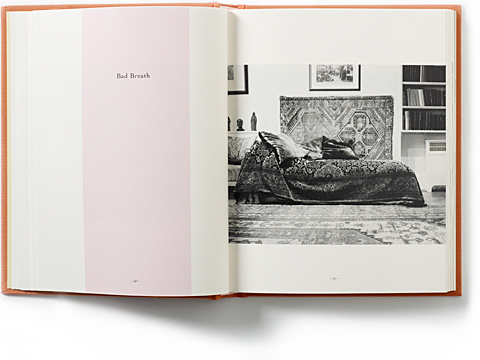User:Inge Hoonte/Appointment with Sigmund Freud
Sophie Calle - Appointment with Sigmund Freud
Thames & Hudson, New York, 2005
Book / Exhibition catalog
The book is dedicated to a man she met, who was born the same day & time as her. they took a flight to Naples together to celebrate their birthday. it occurred to her that they might crash and die together.
Introduction
The book accompanies an exhibition, Appointment, that Calle created at 20 Maresfield Gardens, now known as the Freud Museum in London, where Dr. Freud had lived for a short time, and died. She displayed some of her own personal objects in his house, and selected objects from his collection which relate to stories she wished to tell. The texts were placed on small pink cards placed next to these items.
Basically, the residency, or show, was an opportunity to place her own stories, memories and work in the context of Freud's home, legacy, heritage. Her life in relation to another's.
Each example takes up four pages: title page, previous photo from the archive/museum or her own collection, photo of her/Freud's object in the house, story that relates. I'm not sure how the objects are tied to a specific place in the building.
Entrance
p18-21
Story how she used to undress in the elevator, when she was six, and lived with her grandparents. Then she'd rush down the hall and jump in bed. Years later, she undressed on stage of a strip joint, wearing a blonde wig in case her grandparents would pass by.
p22-25
One of her high heels, with a story about being kicked in the head, the night of her last performance as a stripper.
p26-29
About boobs.
p30-33
How she and her lover used to alternate days on which they took the decisions. When he left, he gave her a dice to replace him. She met a new man, with the same last name, who asked her to sleep with him. She let the dice decide, an act through which her former lover approved of the new lover.
Dining Room

p36-39
A banana with two scoops of vanilla ice cream, a phallic symbol, on the dining table in Freud's home.
p40-43
Her dad sent her to a GP for bad breath, but turned out to be a psycho-analyst. Do you always do what your father tells you to do? And so she became his patient.
Landings
p46-49
She had three cats. They all died. Closely tied to human errors.
p50-53
Coffee. A man asked her to lunch, the following week, so she prepared herself all week on the topic. She was afraid he was too smart for her. He said, the smell of coffee. Then they talked about something else. She stole the coffee cup as a memory.
p54-57
She stayed at a man's house in New York. He wasn't there. She found a note with his new year's resolution. His name is Greg. She thanked him by phone, from Paris. They decided to meet a year later but he never showed up. He called a year later and asked if she wanted to see him. This man knew how to talk to her.
p58-61
Next story is seemingly about the same man. It starts that he's unreliable and showed up a year late for their first date. When he left she required a hostage, so she knew he'd come back. For it/for her. it was a painting of a girl that resembled her. They got married a year later, and he gifted her the painting. She had a husband but no more hostage for his return.
p62-65
She put her own wedding picture next to Freud's wedding picture. it was a staged wedding picture, as she was already married half a year earlier.
p66-69
The Break-up. Greg's love letters to another woman scattered out of a plastic bag, on the floor of Freud's home. Sent during their relationship, now for some reason sent back. She decided to let him go, as he promised the other woman, in October.
p70-73
She thought another man was her father but he never confessed to it.
Dr. Freud's Study

p76-79
She'd always admired him, since she was a child. When she was 30, she visited him. She brought a wedding dress, which she wore on their first night together.
p80-83
Another man. A bathrobe. She was 18, and didn't want to see him from the front, so he hid for a year in the bathrobe. He gave it to her when they split.
p84-87
A mask with glass eyes. She never remembers the color of a man's eyes. A wife should know these things, so she made an effort to fight this amnesia. He has green eyes.
p88-91
The husband didn't sleep with her before he was her husband.
Dorothy Burlingham's Study
p94-97
The red shoe, in a closet. She used to steal from department stores, with her friend Amelie. One day, the girl's mom told them she had outed them to a policeman who was now following them. So they became too busy trying to not be followed, and didn't steal anymore. The last thing they stole was a pair of red shoes that was too big for them. Amelie kept the right one, Sophie the left one.
p98-101
Picture of her nose, en profil. Installed in Freud's house among photos of Anna Freud. Her grandparents said she needed a nose job when she was 14. She was hesitant. She never got it though because the doctor committed suicide two days before the operation.
p102-105
Slashed nude drawing from a workshop. Hung among Anna Freud's degree certificates.
p106-109
Weird psychology. Using a sheet to get an ill man to bed with her.
p110-113
A diary given to her by a stranger who asked her to go to an abandoned house of her adoptive sister parents. They were sisters and adopted her. They died, she was too afraid to go to the house. Calle here focuses on the entries for Christmas, this time of year seems to mean something to her, it's come back a few times.
p114-117
A love letter she paid a public scribe to write for her. Here in Freud's desk, among his writing accessories and glasses.
p118-121
Greg's love letter to H, placed underneath Freud's type writer. She found it two months after their wedding.
p122-125
A man, H, told her a secret, on the last day they spent together during a trip to Seville.
Martha & Sigmund Freud's bedroom
p128-131
She saw him for the first time in 1985, when he was giving a lecture. He was attractive but for his ugly tie. She sent him a tie, which he wore next time she saw him. For the next years, she sent him a clothing item each Christmas. One day she'd like to be introduced to him.
p132-135
TV guide in his bedroom. Last TV guide that her grandmother used before she got really sick and was transfered to a hospital. Life stopped when she left her TV.
p136-139
Ugh. Seems like a troublesome marriage with this Greg. Argument, remains of what he threw at her restaged on Freud's floor.
p140-143
She held Greg's penis when he peed. One last time on the day she agreed to their divorce.
p144-147
A photo with a mark in her neck. A few days later, a man tried to strangle her. She ran into him again a few days later, he said it was all a mistake, apologized and asked her to be the godmother of his baby.
p148-151
Display of bed remains (her bed, lit on fire by her mother's tenant, with him in it, who died), and other items from Freud.
AFTERWORD
The work had been displayed elsewhere previously. Both curator and Calle knew this would be the definitive context for Histoires Vraies. True Stories, although with a lot of them you wonder if that's true... When Freud moved into this house, he tried arranging it as accurately as possible exactly as his study in Vienna. Calle's objects and stories immediately engage in dialog with Freud's belongings. Unlocking the past, to him, is making sense of the present. "Sophie's texts, which reveal her compulsive rituals, obsessions, and fantasies, have inevitable parallels with a psychoanalyst's case book, where memory, imagination, emotion, desire, and loss are interwoven." (James Putnam, curator of the show) Her objects and texts are a phantom patient, revealing her secrets to Freud, but also to the audience.
From commentary by Marie Desplechin on Center for Fine Art show, 2009, which includes many of the works I saw in her retrospective at the Centre Pompidou in 2003.
"Every child at play behaves like a writer, to the extent that he is creating a world of his own invention - or, rather, arranging this world to his own liking... He plays seriously. It is not seriousness that conflicts with play, but reality."-- S. Freud, "Le créateur littéraire et la fantaisie", L'Inquiétante Étrangeté et autres récits, Gallimard, 1985.
Sophie's on a "... war against pain."

